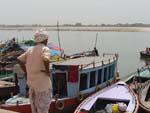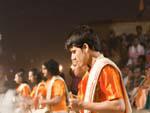We arrived into Varanasi late at night after catching a five or so hour train from Gorukpur. Upon arriving at the train station, we were met with a vast collection of auto and cycle rickshaws (and their drivers!), keen to win our business. We negotiated a fee with one auto rickshaw driver but after he took us to his rickshaw, he changed his mind and advised us to take a cycle rickshaw instead, as the B&B we wanted to stay at was supposedly not accessible by autorickshaw (or something along those lines).
We ended up taking a cycle rickshaw through the old city towards the Ganges, where we were staying. It dropped us off about five-hundred metres away from our hotel, telling us that cycle rickshaws weren’t allowed any further (again, this was supposedly the reason).
The B&B was hard to find in the dark and narrow alleys. It was a little spooky as there was no lighting, although my biggest fear being that I would step on cow dung which is almost always littered across the streets of Indian cities.
We managed to get a non-AC room, nominated in the Lonely Planet as an ‘our pick/top choice’. It was a big mistake as it was so hot that night! Possibly because of the design of the room and choice of building material. The next morning we awoke to see our first glimpses of the spiritual Ganges on our hotel rooftop. It was so much wider than I expected. Boats were floating by, filled to the brim with people. Colourful buildings were sprinkled along the river side.
We decided to wander along the river, passing along the ghats. Along the way we were spotted by a local man who took it upon himself to walk alongside us and explain the different ghats. Eventually we reached the Manikarnika ghat which is the main ghat for cremation. As it was still early in the morning, we witnessed some ceremonial rites for the deceased, and the actual cremation. It was a surreal experience. The local guy, turned out to be a tout, passed us along to a man who supposedly worked there who explained a few things about the cremations and ended up wanting a significant ‘donation’ for the wood used in the cremation (we did not succumb to his request). Understandably, photography is not allowed in this ghat.
We continued back, passing through the other ghats – Lalita ghat, Manmandir ghat. The heat of the midday sun was approaching, and there weren’t many people around, aside from men washing clothes along the river and some local tourists.
We headed to a local joint for lunch – where we devoured a thali each. After we headed to the famous Blue Lassi Cafe well known for its delicious lassis (but terribly hard to find). I had a papaya lassi and Travis went for the mango lassi. Both were incredible and were only thirty rupees each.
thydzikgooglemap(http://sonyaandtravis.com/maps/varanasi-india.xml,s)
As the sun began to set, we headed back to the ghats to witness the evening ceremony (Ganga Aarti) that take place each night. Aarti is a Hindu religious ritual where light from wicks are soaked in ghee and is offered to Hindu deities. We headed to the bustling Dashashwamedh ghat firstly. There were so many people around now that the sun was setting and it was cooler. Young children were selling baskets containing marigolds and tealights for puja (offerings to Hindu deities). Bright yellow and orange flowers were strewn alongside the jetties. Candles floated in the water. Food vendors were selling snacks and water. Boats were patiently lined at the dock waiting to bring people onto the Ganges to watch the ceremony. It was an overwhelming mix of spirituality and excitement. Many of the pilgrims were local tourists who had travelled far and wide to perform puja at the holy Ganges.
At about seven in the evening some male performers appeared onto the stage and the ceremony commenced. There was dancing, singing (songs of praises to deities), bells and open flames. We could see that a similar performance was taking place at another nearby ghat. We noticed that those who had paid to ride the boats had probably the best view as the stage faced the Ganges.
After the Aarti we headed back, keen to get a good rest for our early morning Ganges river boat ride.

































































































































